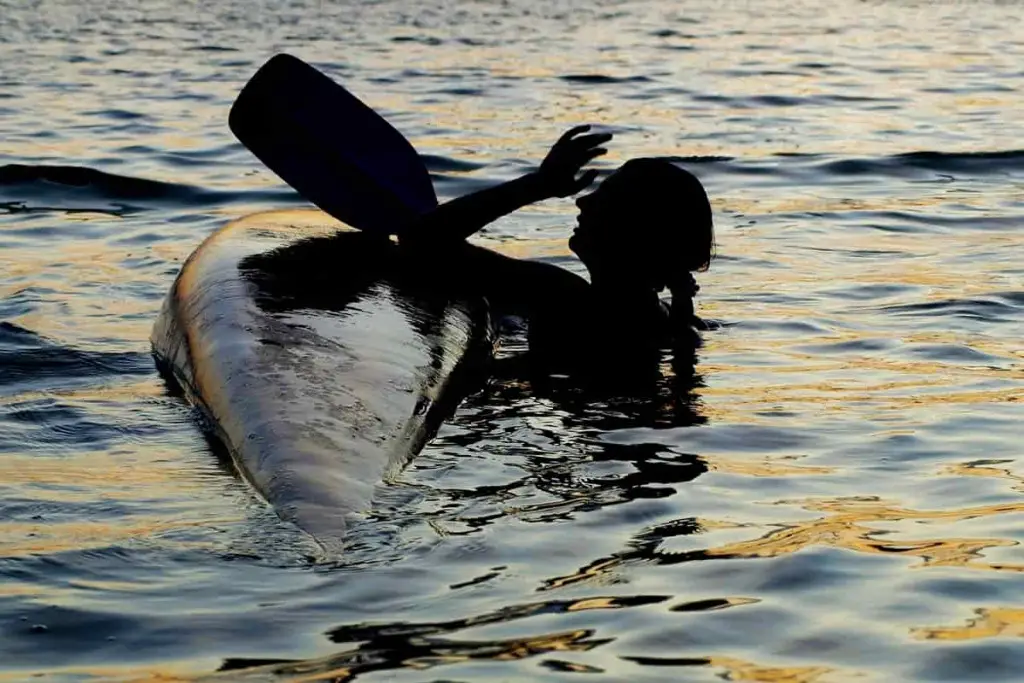
Kayak fishing can be a lot of fun, but it generally loses its luster if the kayak starts going under. Suddenly, a nice day out on the lake can turn into a cold, wet proposition, and that’s the best-case scenario. But what are you supposed to if your fishing kayak starts sinking? Well, that depends on why it’s sinking.
If your fishing kayak starts sinking, the first thing to do is try to determine the reason for it. You should start bailing water out of the inside of the kayak, but if it keeps filling up, you probably have a leak, and you can’t do much. If your kayak is overloaded, you’ll have to get rid of some of the gear you have inside.
When it comes to sinking kayaks, the saying that an ounce of prevention is worth a pound of cure is certainly applicable. There are quite a few items you can and should purchase to prevent sinking and be prepared just in case you start sinking. Keep reading to find out how to deal with a sinking kayak and prevent sinking in the first place.
How to Deal with a Fishing Kayak That’s Sinking
There are two reasons your fishing kayak may be sinking; either you’ve gotten too much water on board due to a leak or other situation, or the load on your kayak is too heavy for it to remain buoyant. These situations are very different, and they have different ways to respond when they happen.
Sit-On-Top Kayaks
Many fishermen use what are called sit-on-top kayaks, where there isn’t a traditional hole in the top for them to sit in, called a sit-in kayak. These kayaks are essentially unsinkable; they have self-bailing holes that keep them pretty well-drained. As long as you don’t exceed the recommended weight capacity, you won’t sink them.
Leak or Water on Board
A kayak has an empty hull for your legs, but it’s also possible for water to get in there, especially if the water your kayaking on is rough. If your hull has a crack or a hole in it, you’ll get water inside. If you haven’t noticed the crack, you may not be aware of the water if it’s a slow leak.
If you start getting water on board, you should bail it out immediately. If it keeps coming back, you probably leak, and you need to get back to shore as soon as possible. There’s not a good way to patch a leak while you’re out on the water. If it’s just a matter of rough conditions, you may be able to find a calmer spot or get out of the water.
Too Much Weight on Board
The other way that a fishing kayak can sink is if it has too much weight on board. You’d likely notice this as soon as you get on your kayak when you first start; if it starts sinking, you have too much weight. If your kayak is sitting low in the water when you start, you should be careful while fishing; a few good catches might get too heavy.
Do Kayaks Ever Sink?
Luckily, it’s very difficult to sink a kayak. Kayaks are very durable and resilient materials that stand up well to the possible bumps and bruises they could take on the water; the only thing that might put a hole in them is hitting a rock at high velocity or maybe an underwater branch or something.
They can sustain cracks if mistreated when out of the water, but you should always do a visual inspection of your kayak before use to make sure they aren’t there. Likewise, making sure it’s properly stored and transported is essential to keeping it from being damaged. In reality, if there’s no damage to a kayak, the only way for it to sink is if you ignore the weight limit.
Preventing a Kayak from Sinking in the First Place
Of course, you don’t want your expensive fishing kayak sinking in the first place, so there are a few steps you can take and gear you can purchase to prevent it from happening. Below is a table summarizing these steps.
| Description | Purpose |
| Spray Skirt | Closes the open hole you sit in in a kayak to prevent water from getting inside |
| Visual inspections | Consistently inspect your kayak for dents, abrasions, or cracks that could lead to issues, and repair as needed |
| Bailing Bucket | Can be an old water jug, keep on board to help bail out water when it gets in |
| Large sponge | Keep in the bottom of your kayak to soak up water, then just wring out periodically |
Storage Hatches
If you use a sit-on-top kayak for fishing, you probably have a small storage hatch at the front of the kayak to store extra fishing gear or whatever. Make sure you check it periodically while using it to see if it’s open and taking on water. Kayaks usually seal well, so as long as it’s closed, it shouldn’t allow water inside.
Continually Inspecting Your Kayak
You should always inspect your kayak before and after rides to check for possible cracks or dents that need to be repaired. Better kayaks will be made from more durable polyethylene materials, better able to stand up to the beatings they might take during use, but they’re not indestructible.
Do a quick visual inspection of the hull and make sure there aren’t any cracks. Repair those cracks immediately. Repairing plastic on a kayak isn’t necessarily quick, but it’s a relatively easy process. If you don’t want to do it, find a good boat repair shop to fix it.
Why You Should Always Wear a Lifejacket
Finally, you should always wear a lifejacket while you’re on your kayak. Even if you think you’re a good swimmer, you never know what’s going to happen out on the water, and a lifejacket will help save your life if you’re knocked unconscious or unable to swim. If all else fails and your kayak starts to sink, you should at least have a lifejacket to help you get back to shore.
Many states have laws about wearing lifejackets on a kayak; generally speaking, you don’t necessarily need to be wearing it, but every vessel out on the water needs to have one on board that’s readily accessible and sized for the rider.
Since fishing kayaks are limited in space, it’s usually easier to just wear the thing. There’s always a chance for disaster to strike while you’re on the water, and it’s best to be prepared.
Related Articles
- Do Fishing Kayaks Flip Over Easily? The 3 Common Causes!
- How Stable Is a Fishing Kayak?
- What Are Holes in a Kayak For? Should You Plug Them?
- Can You Kayak on Any Body of Water Legally? The Truth
Closing Thoughts
Kayaks are a lot of fun, and a fishing kayak can be a great way to spend a day out on the lake without breaking the bank with a huge boat. You can put it in your car and easily lift it and put it in the water. They’re made to be durable, so generally speaking, as long as they don’t have any damage to them and stay under the weight limit, they won’t sink.
However, if you find your kayak sinking, you should start bailing it out immediately and heading for shore. Hopefully, you’re wearing your lifejacket, so if you end up in the water, you’ll be able to float. Safety first!
Have fun, and stay safe out there!
